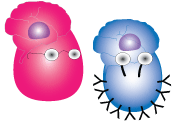
Inducible Treg differentiation
Human intestines contain a large number of protein antigens. While some come from microorganisms that are part of our commencal flora, others get there after eating food like a peanut butter sandwich. Proteins in the gut get broken down into small pieces and amazingly, the immune system can tell the difference between the harmful and the harmless bits. This oral tolerance is due to subsets of T cells induced locally in intestinal tissue that are able to stop unnecessary immune responses to harmless antigens, like food antigens. Examples of these subsets are the Tr1 and Th3 subset as well as the inducible T regulatory cells (iTregs), which just like the nTregs that derive from the thymus, are Foxp-3+. Similar to the Th1 and Th2 cells that we learned about in the previous page, these regulatory T cell subsets differentiate from the naive CD4+ T cell under the influence of cytokines produced by APC like macrophages and DCs. These gatekeepers of oral tolerance are located in the abdominal lymph nodes and the liver. So what is the difference in antigen presentation that in this case leads to differentiation into a tolerogenic T cell subset? Although gut tolerance is a very complex matter with many contributing factors, there is one basic feature about these APCs, presenting antigens from harmless proteins, which is that there is no reason for alarm. There is no danger as no damage has been done to the host! Under these non-inflammatory conditions APCs will present antigens in an immature or semi-mature state, which we know from the linker module is not as efficient as presentation by a fully mature APC. These APCs also produce transforming growth factor β (TGF-β) and IL-10, which are two cytokines able to drive differentiation towards T regulatory subsets. Both IL-10 and TGF-β also turns off Th1 cell differentiation by preventing APCs from producing the required IL-12. Many Treg subsets also produce TGF-β and IL-10 and this is one way by which Treg cells can suppress immune responses. We will look into this more in later pages.